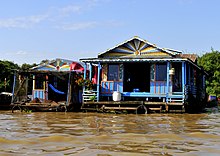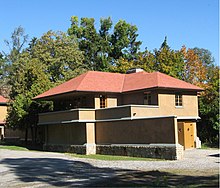Apartment
![]()
The title of this article is ambiguous. For other meanings, see Apartment (disambiguation).
A dwelling is an enclosed space or an escape of several rooms used for living or sleeping. Dwelling is a collective term for all types of dwellings, buildings and rooms that can serve as a residence, such as dormitory rooms, bunkhouses, single-family houses, cabins, living caves, caravans, mobile homes and houseboats. While the term living space refers to individual habitable rooms (rooms) and, as a plural noun, also to the genus of habitable rooms, the term dwelling always refers to an individual unit of such rooms.
In a narrower sense and colloquially, a "flat" is understood to be a housing unit within a block of flats (apartment) equipped with facilities for running a household, often in distinction to a (residential) house or to a room.
This article deals with housing, i.e. dwellings in the broader sense. Architecture and interior design are concerned with the design of dwellings, and housing construction with their planning and execution. Other areas related to housing include housing subsidies, housing psychology, housing and housing law, housing welfare, housing assistance, the housing market, housing policy and the housing industry. The totality of institutions, activities and regulations for the provision of housing to the population is referred to as housing.

A houseboat can also be a dwelling.
Word and term "reside"
The verb "to dwell" goes back to Mhd. wonen, Ahd. wonên (weilen, wohnen, hausen, bleiben, leben, sich aufhalten, verharren, ruhen, sein) and Proto-Germanic *wunēn, *wunǣn (gewohnt sein, zufrieden sein, wohnen). In German the Proto-Germanic root became more productive than in other languages; thus words like gewöhnen, Wonne, Wunsch, Wahn, gewinnen, and gönnen also arose from it. In the meaning of "dwell", a verb wonen exists to this day otherwise only in Dutch and in some related minority languages. In English, a Middle English verb wonen ("to dwell") developed from Old English wunian, preserved as the participle won (to the verb to win, "to gain"); the noun wont ("habit"), which remains closer to the original meaning, is now considered ancient. The verb bo, búa, búgva ("to dwell"), common in the North Germanic languages, does not go back to the Proto-Germanic *wunēn, but to a root *bo- independent of it.
In philosophy, Martin Heidegger attempted a precise definition of the term "dwelling", which has remained inspiring for architecture to this day (Bauen Wohnen Denken, 1951).

The Frankfurt kitchen from 1926 (reconstruction)

Sample living room at the Leipzig Spring Fair 1950
Housing Typology
A 'house' is usually referred to when the dwelling either does not directly touch other dwellings or is separated from other dwellings exclusively by walls (communal, fire or double walls). If, on the other hand, the separation is also or exclusively by ceilings, or if there are also significant premises in the same building used for other than residential purposes (e.g. business premises), it is more likely to be referred to as a 'dwelling'. The definition of a 'house' as a 'whole building' is in some cases (e.g. semi-detached houses with communal walls and common installations) not sufficiently clear-cut.
Apartments can be divided into types according to different criteria:
Houses:
- according to the type of horizontal arrangement:
· (Detached) single-family house (no contact with other dwellings)
· Semi-detached house (wall contact with 1 other apartment)
· Terraced house (wall contact with up to 2 other flats)
· Back of the house
- according to the size and effort of the design:
· Tiny House, Cabin, Barracks, Villa, Castle, etc.
- after the residents:
· Farmhouse, Seldnerhaus, vintner's house, patrician's house, vicarage, etc.
- by type of use:
· weekend house, dacha, alpine hut
See also: Category:Building form (residential building)
(Floor) apartments:
- according to the vertical position and extension in the building:
· Basement apartment (the floor of the apartment is below ground level)
· Maisonette (often extends over several floors and usually includes the top floor and the attic)
· Mansard apartment (in the attic)
· Penthouse (an apartment built on top of another house; also called an attic apartment in Switzerland)
- according to size and cut:
· granny annexe (a small additional dwelling in a home which is of secondary importance to the main dwelling)
· Garçonnière (a one-room apartment, depending on the layout also with a separate kitchen room or storeroom)
· Micro apartment (as before, but very small)
- according to the type of building:
· Loft apartment (an apartment furnished in a former factory or warehouse).
- after the date of construction of the building (mainly in Germany):
· Old building apartment (built before the Second World War, with typical features such as masonry walls, wooden beam ceilings, box windows and room heights over 2.6 m)
· New construction dwellings (dwellings in a newly constructed or reconstructed building. The period for which such a building is considered new construction is inconsistent and, depending on the context, ranges, for example, either until the first necessary refurbishment because the building shows visible signs of wear or because the current architectural style or construction technology has changed to such an extent that the building would no longer be newly constructed in this form. There is no specifically defined designation for apartments in houses built between the old and new construction phases. Sometimes apartments from the first years after World War II are referred to as post-war buildings, and in East Germany until the beginning of prefabricated housing [ca. 1965] also as apartments in old new buildings. Otherwise, apartments and houses are classified according to the decade of their construction, e.g. "...from the eighties").
- according to the ownership structure:
· condominium (apartment is owned by individual persons, often the residents of the apartment)
· Rented apartment (apartment is owned by a landlord)
· Company flat, company flat (flat is the property of the tenant's employer)
- according to the purpose of the rental:
· Holiday flat (flat is only let for a limited period and mainly to holidaymakers)
In the case of buildings containing several dwellings, a distinction is made between, among others, two-family houses, multi-family houses, terraced houses, apartment blocks and high-rise apartment buildings.
Room:
- in the case of individual rooms, according to the type of person accommodated (e.g. guest room, servants' quarters, maids' quarters)
- in the case of collective accommodation, according to the type of accommodation (e.g. room in a hotel, boarding house, room in an orphanage or boarding school, room in a children's, single people's, nursing or old people's home, room in a student hall of residence or in refugee accommodation, sick room, monastery cell, dormitory, barracks room, prison cell and many others)

The Frank Lloyd Wright-designed Graycliff estate in Derby, south of Buffalo, New York has a chauffeur's apartment above the garage, as did many wealthy residences of the period.
Questions and Answers
Q: What is an apartment?
A: An apartment is a place to live that is part of a larger building, usually consisting of one or more rooms on one floor in a city.
Q: What are two types of ownership structures for apartments?
A: Two types of ownership structures for apartments are condominiums and housing cooperatives.
Q: Who is the owner of a rented apartment?
A: The owner of a rented apartment is called the landlord.
Q: What do tenants have to pay to the landlord when renting an apartment?
A: Tenants have to pay rent money or rent to the landlord when renting an apartment.
Q: Do all apartments include utilities such as electricity and heat?
A: No, not all apartments include utilities such as electricity and heat. In some cases, tenants will have to pay extra for these services.
Q: What kind of facilities may be provided by an apartment complex? A: An apartment complex may provide recreational facilities such as swimming pools, mini golf courses, movie theaters, bowling alleys and others.
Search within the encyclopedia